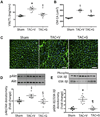Simultaneous adrenal and cardiac g-protein-coupled receptor-gβγ inhibition halts heart failure progression
- PMID: 24703913
- PMCID: PMC4083020
- DOI: 10.1016/j.jacc.2014.02.587
Simultaneous adrenal and cardiac g-protein-coupled receptor-gβγ inhibition halts heart failure progression
Abstract
Objectives: The authors propose simultaneous inhibition of Gβγ signaling in the heart and the adrenal gland as a novel therapeutic approach for heart failure (HF).
Background: Elevated sympathetic nervous system activity is a salient characteristic of HF progression. It causes pathologic desensitization of β-adrenergic receptors (β-AR), facilitated predominantly through Gβγ-mediated signaling. The adrenal glands are key contributors to the chronically elevated plasma catecholamine levels observed in HF, where adrenal α2-AR feedback inhibitory function is impaired also through Gβγ-mediated signaling.
Methods: We investigated the efficacy of a small molecule Gβγ inhibitor, gallein, in a clinically relevant, pressure-overload model of HF.
Results: Daily gallein treatment (10 mg/kg/day), initiated 4 weeks after transverse aortic constriction, improved survival and cardiac function and attenuated cardiac remodeling. Mechanistically, gallein restored β-AR membrane density in cardiomyocytes, attenuated Gβγ-mediated G-protein-coupled receptor kinase 2-phosphoinositide 3-kinase γ membrane recruitment, and reduced Akt (protein kinase B) and glycogen synthase kinase 3β phosphorylation. Gallein also reduced circulating plasma catecholamine levels and catecholamine production in isolated mouse adrenal glands by restoring adrenal α2-AR feedback inhibition. In human adrenal endocrine tumors (pheochromocytoma), gallein attenuated catecholamine secretion, as well as G-protein-coupled receptor kinase 2 expression and membrane translocation.
Conclusions: These data suggest small molecule Gβγ inhibition as a systemic pharmacologic therapy for HF by simultaneously normalizing pathologic adrenergic/Gβγ signaling in both the heart and the adrenal gland. Our data also suggest important endocrine/cardiovascular interactions and a possible role for small molecule Gβγ inhibition in treating endocrine tumors such as pheochromocytoma, in addition to HF.
Keywords: catecholamines; fibrosis; heart failure; hypertrophy; sympathetic nervous system.
Copyright © 2014 American College of Cardiology Foundation. Published by Elsevier Inc. All rights reserved.
Figures







Comment in
-
Promising small molecule for heart failure targeting adrenal catecholamine release and β-adrenergic receptor signaling in the heart.J Am Coll Cardiol. 2014 Jun 17;63(23):2558-2559. doi: 10.1016/j.jacc.2014.03.010. Epub 2014 Apr 2. J Am Coll Cardiol. 2014. PMID: 24703911 No abstract available.
Similar articles
-
Small molecule disruption of G beta gamma signaling inhibits the progression of heart failure.Circ Res. 2010 Aug 20;107(4):532-9. doi: 10.1161/CIRCRESAHA.110.217075. Epub 2010 Jun 24. Circ Res. 2010. PMID: 20576935 Free PMC article.
-
Pharmacological and Activated Fibroblast Targeting of Gβγ-GRK2 After Myocardial Ischemia Attenuates Heart Failure Progression.J Am Coll Cardiol. 2017 Aug 22;70(8):958-971. doi: 10.1016/j.jacc.2017.06.049. J Am Coll Cardiol. 2017. PMID: 28818206 Free PMC article.
-
Promising small molecule for heart failure targeting adrenal catecholamine release and β-adrenergic receptor signaling in the heart.J Am Coll Cardiol. 2014 Jun 17;63(23):2558-2559. doi: 10.1016/j.jacc.2014.03.010. Epub 2014 Apr 2. J Am Coll Cardiol. 2014. PMID: 24703911 No abstract available.
-
Taking the heart failure battle inside the cell: small molecule targeting of Gβγ subunits.J Mol Cell Cardiol. 2011 Oct;51(4):462-7. doi: 10.1016/j.yjmcc.2011.01.006. Epub 2011 Jan 21. J Mol Cell Cardiol. 2011. PMID: 21256851 Free PMC article. Review.
-
GRK2 inhibition in heart failure: something old, something new.Curr Pharm Des. 2012;18(2):186-91. doi: 10.2174/138161212799040510. Curr Pharm Des. 2012. PMID: 22229578 Review.
Cited by
-
The expanding GRK interactome: Implications in cardiovascular disease and potential for therapeutic development.Pharmacol Res. 2016 Aug;110:52-64. doi: 10.1016/j.phrs.2016.05.008. Epub 2016 May 12. Pharmacol Res. 2016. PMID: 27180008 Free PMC article. Review.
-
Targeting Polyphosphate Kinases in the Fight against Pseudomonas aeruginosa.mBio. 2021 Aug 31;12(4):e0147721. doi: 10.1128/mBio.01477-21. Epub 2021 Aug 3. mBio. 2021. PMID: 34340551 Free PMC article.
-
Canonical or non-canonical, all aspects of G protein-coupled receptor kinase 2 in heart failure.Acta Physiol (Oxf). 2025 Mar;241(3):e70010. doi: 10.1111/apha.70010. Acta Physiol (Oxf). 2025. PMID: 39960030 Free PMC article. Review.
-
Paroxetine-mediated GRK2 inhibition reverses cardiac dysfunction and remodeling after myocardial infarction.Sci Transl Med. 2015 Mar 4;7(277):277ra31. doi: 10.1126/scitranslmed.aaa0154. Sci Transl Med. 2015. PMID: 25739765 Free PMC article.
-
From Bench to Bedside: New Approaches to Therapeutic Discovery for Heart Failure.Heart Lung Circ. 2016 May;25(5):425-34. doi: 10.1016/j.hlc.2016.01.002. Epub 2016 Jan 19. Heart Lung Circ. 2016. PMID: 26993094 Free PMC article. Review.
References
-
- Bristow MR, Ginsburg R, Minobe W, et al. Decreased catecholamine sensitivity and beta-adrenergic-receptor density in failing human hearts. N Engl J Med. 1982;307:205–211. - PubMed
-
- Rockman HA, Koch WJ, Lefkowitz RJ. Seven-transmembrane-spanning receptors and heart function. Nature. 2002;415:206–212. - PubMed
-
- Koch WJ, Lefkowitz RJ, Rockman HA. Functional consequences of altering myocardial adrenergic receptor signaling. Annu Rev Physiol. 2000;62:237–260. - PubMed
-
- Naga Prasad SV, Barak LS, Rapacciuolo A, Caron MG, Rockman HA. Agonist-dependent recruitment of phosphoinositide 3-kinase to the membrane by beta-adrenergic receptor kinase 1. A role in receptor sequestration. J Biol Chem. 2001;276:18953–18959. - PubMed
Publication types
MeSH terms
Substances
Grants and funding
LinkOut - more resources
Full Text Sources
Other Literature Sources
Medical
Research Materials
Miscellaneous

